

Compact Muon Solenoid
LHC, CERN
| CMS-PAS-TOP-16-020 | ||
| Evidence for the standard model production of a Z boson with a single top quark in pp collisions at √s= 13 TeV | ||
| CMS Collaboration | ||
| September 2017 | ||
| Abstract: Evidence for the standard model production of a Z boson in association with a single top quark is presented. The study uses a data sample of proton-proton collisions at √s= 13 TeV recorded in 2016 by the CMS experiment, corresponding to an integrated luminosity of 35.9 fb−1. Final states with three leptons (electrons or muons) and at least two jets are investigated. The corresponding measured tZq measured cross section is σ(pp→tZq→Wbℓ+ℓ−q)= 123+44−39 fb, where ℓ stands for electrons, muons, and taus, with an observed (expected) significance of 3.7 (3.1) standard deviations. | ||
|
Links:
CDS record (PDF) ;
CADI line (restricted) ;
These preliminary results are superseded in this paper, PLB 779 (2018) 358. The superseded preliminary plots can be found here. |
||
| Figures | |
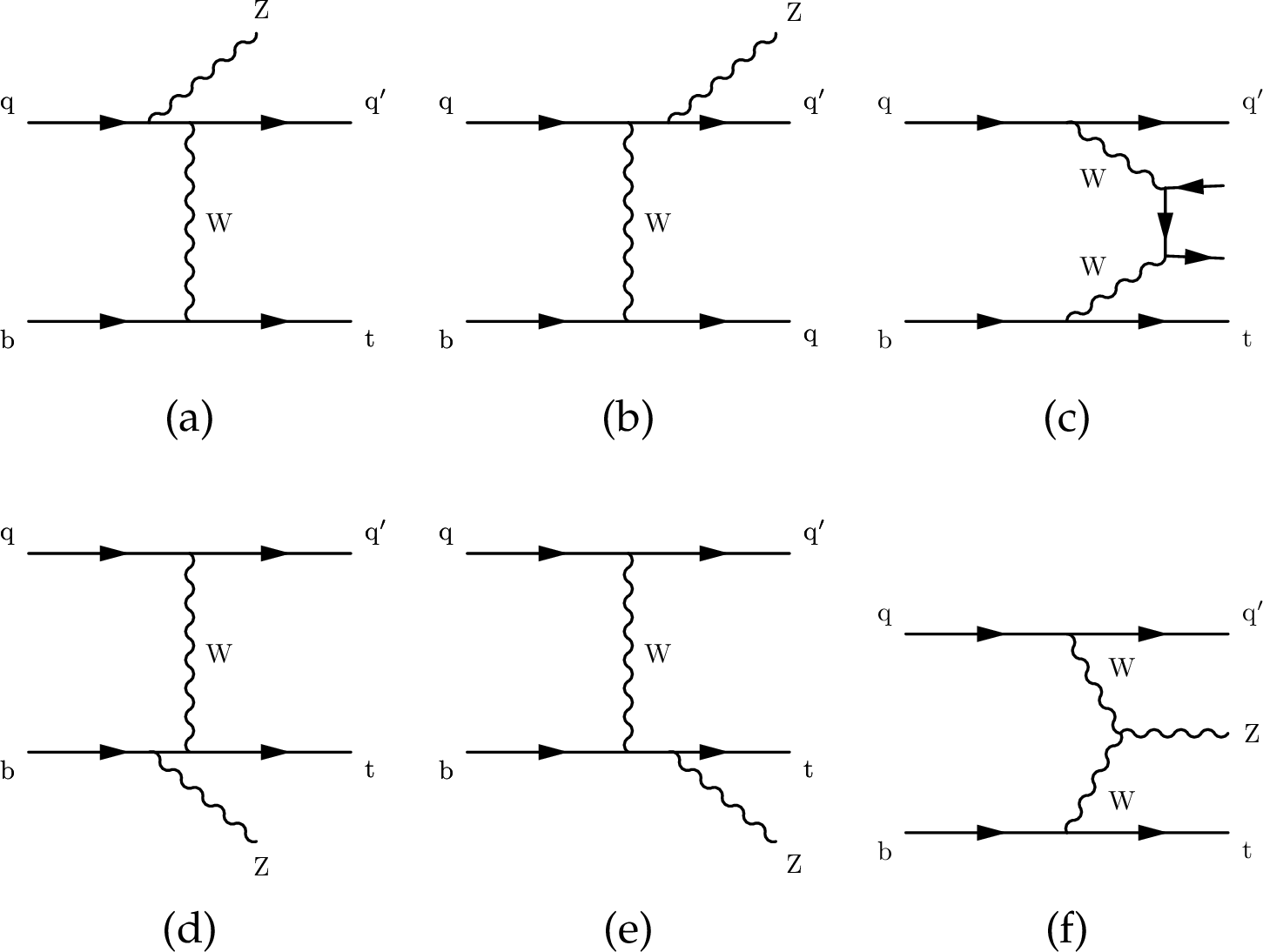
png pdf |
Figure 1:
Leading order tZq production diagrams. The initial- and final-state quarks, denoted q and q', are predominantly first-generation quarks, although there are smaller additional contributions from strange- and charm-initiated diagrams. Diagram (c) represents the non-resonant contribution to the tZq process. |

png pdf |
Figure 1-a:
Leading order tZq production diagrams. The initial- and final-state quarks, denoted q and q', are predominantly first-generation quarks, although there are smaller additional contributions from strange- and charm-initiated diagrams. Diagram (c) represents the non-resonant contribution to the tZq process. |
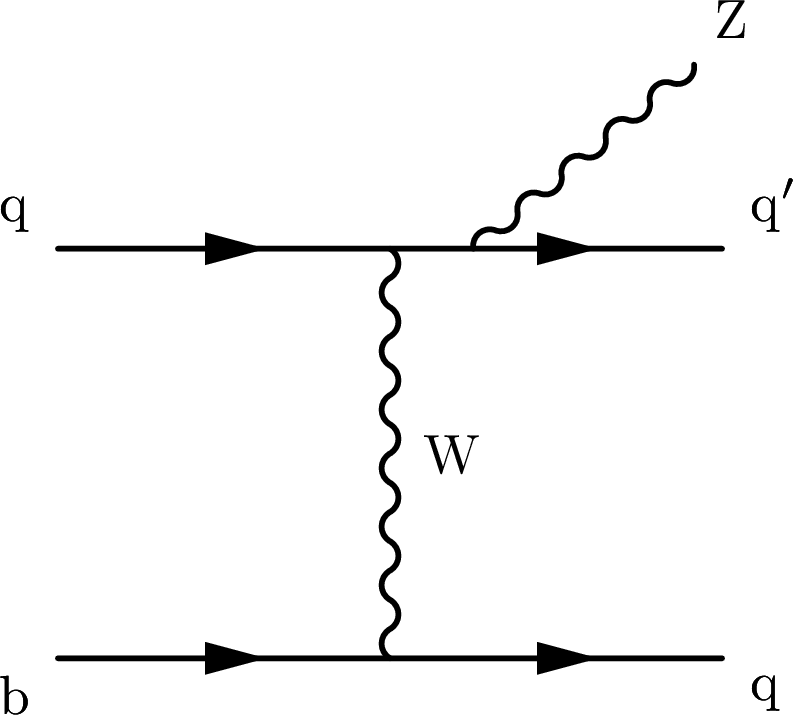
png pdf |
Figure 1-b:
Leading order tZq production diagrams. The initial- and final-state quarks, denoted q and q', are predominantly first-generation quarks, although there are smaller additional contributions from strange- and charm-initiated diagrams. Diagram (c) represents the non-resonant contribution to the tZq process. |

png pdf |
Figure 1-c:
Leading order tZq production diagrams. The initial- and final-state quarks, denoted q and q', are predominantly first-generation quarks, although there are smaller additional contributions from strange- and charm-initiated diagrams. Diagram (c) represents the non-resonant contribution to the tZq process. |
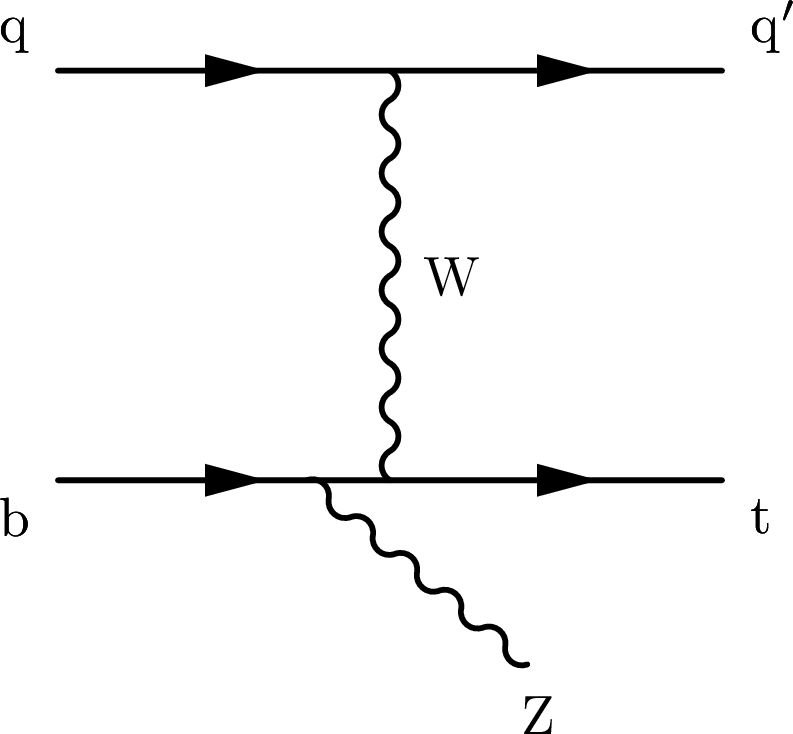
png pdf |
Figure 1-d:
Leading order tZq production diagrams. The initial- and final-state quarks, denoted q and q', are predominantly first-generation quarks, although there are smaller additional contributions from strange- and charm-initiated diagrams. Diagram (c) represents the non-resonant contribution to the tZq process. |
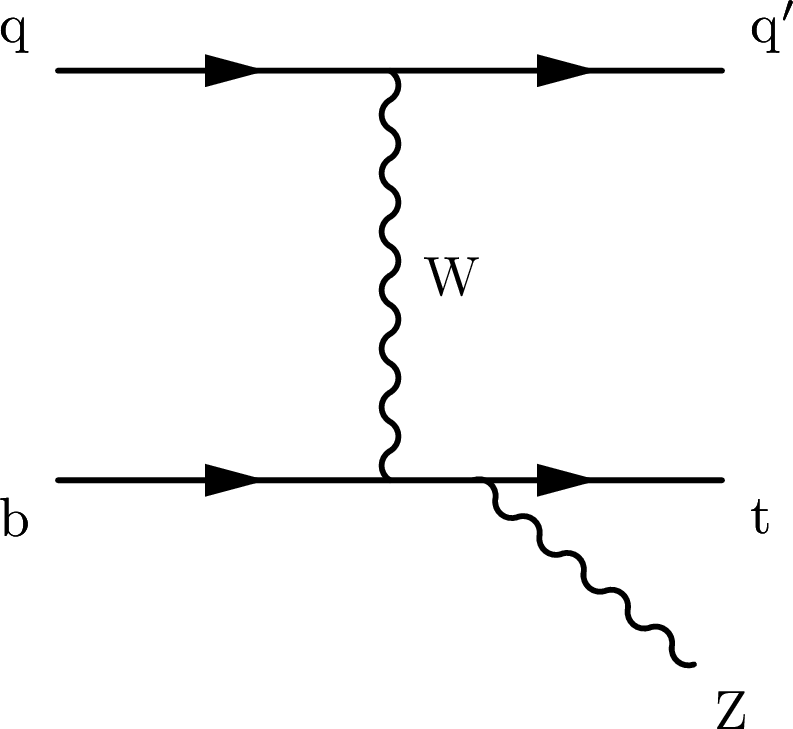
png pdf |
Figure 1-e:
Leading order tZq production diagrams. The initial- and final-state quarks, denoted q and q', are predominantly first-generation quarks, although there are smaller additional contributions from strange- and charm-initiated diagrams. Diagram (c) represents the non-resonant contribution to the tZq process. |
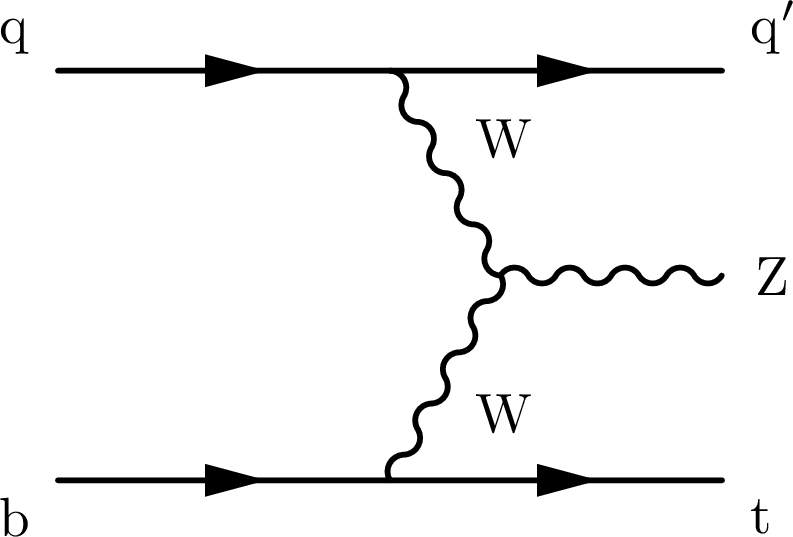
png pdf |
Figure 1-f:
Leading order tZq production diagrams. The initial- and final-state quarks, denoted q and q', are predominantly first-generation quarks, although there are smaller additional contributions from strange- and charm-initiated diagrams. Diagram (c) represents the non-resonant contribution to the tZq process. |
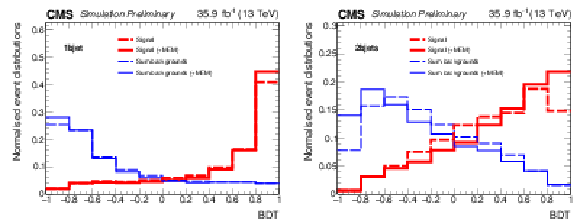
png pdf |
Figure 2:
Normalised distributions of the BDT output for signal (thick lines) and backgrounds (thin lines). The discriminants including (excluding) MEM variables in the BDT training are shown as dashed (solid) lines for the 1 bjet (left) and 2 bjets (right) regions. Contributions from all channels are included. |
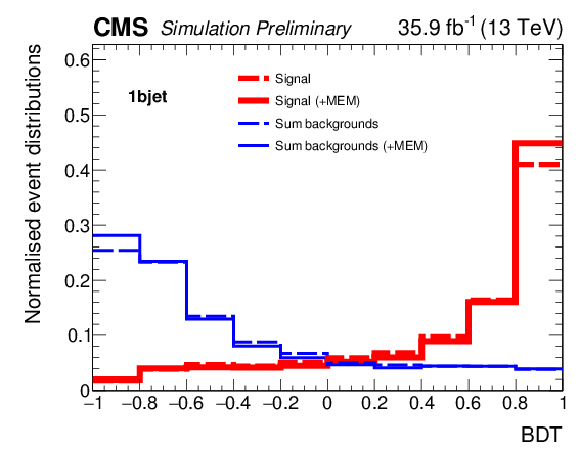
png pdf |
Figure 2-a:
Normalised distributions of the BDT output for signal (thick lines) and backgrounds (thin lines). The discriminants including (excluding) MEM variables in the BDT training are shown as dashed (solid) lines for the 1 bjet (left) and 2 bjets (right) regions. Contributions from all channels are included. |

png pdf |
Figure 2-b:
Normalised distributions of the BDT output for signal (thick lines) and backgrounds (thin lines). The discriminants including (excluding) MEM variables in the BDT training are shown as dashed (solid) lines for the 1 bjet (left) and 2 bjets (right) regions. Contributions from all channels are included. |
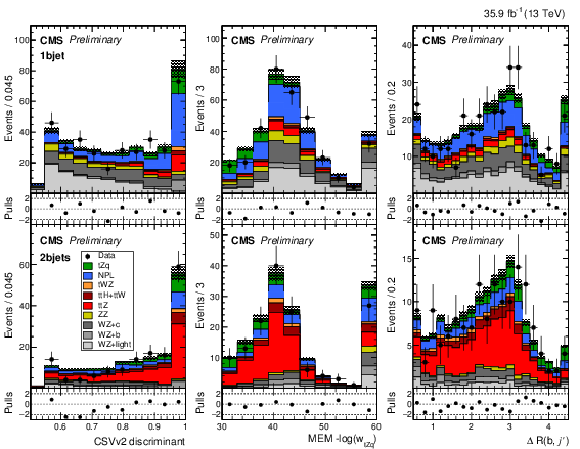
png pdf |
Figure 3:
Data-to-prediction comparisons in the 1 bjet (signal-enriched) region (upper row) and in the 2 bjets region (bottom row) for the highest CSVv2 discriminator among all selected jets (left), the negative values of the logarithm of the MEM score associated to the most probable tZq kinematic configuration (center), and the ΔR separation between the b quark and recoiling jets (right). The distributions include events from all final states. Underflows and overflows are included in the first and last bins, respectively. The predictions correspond to the normalisations obtained after the fit described in Section xxxxx. The hatched bands include the total uncertainty on the background and signal samples. |
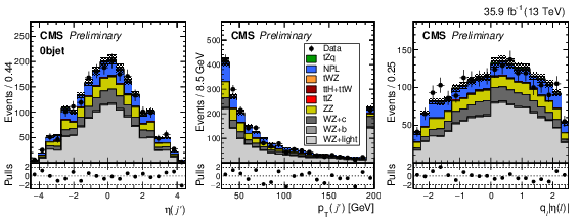
png pdf |
Figure 4:
Data-to-prediction comparisons in the 0 bjet region for the η (left) and pT (centre) of the recoiling jet, and the additional lepton asymmetry (right). More details are given in the caption of Fig. yyyyy. |
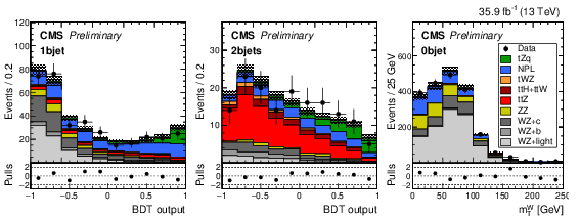
png pdf |
Figure 5:
Template distributions used for signal extraction. Left: BDT discriminant in the 1 bjet region; centre: BDT discriminant in the 2 bjets control region; mWT in the 0 bjet control region. |
| Tables | |

png pdf |
Table 1:
Observed and expected (post-fit) yields for each production process in the 1 bjet region. The yields of columns 2-5 correspond to each channel, and that of column 6 displays the total for all channels. The last column displays the ratio between post- and pre-fit yields. |
| Summary |
| The associated production cross section of a top quark and a Z boson is measured using data from pp collisions at 13 TeV collected by the CMS experiment. The measurement uses events containing three charged leptons in the final state. Evidence for tZq production is found with an observed (expected) significance of 3.7 (3.1). The cross section is measured to be σ(tℓ+ℓ−q)= 123+33−31 (stat) +29−23 (syst) fb, compatible with the NLO SM prediction of 94.2 ± 3.1 fb. |
| References | ||||
| 1 | M. Czakon, P. Fiedler, and A. Mitov | Total top-quark pair-production cross section at hadron colliders through O(α4S) | PRL 110 (2013) 252004 | |
| 2 | CDF and D0 Collaborations | Tevatron combination of single-top-quark cross sections and determination of the magnitude of the Cabibbo-Kobayashi-Maskawa Matrix Element Vtb | PRL 115 (2015) 152003 | |
| 3 | CDF and D0 Collaborations | Observation of s-channel production of single top quarks at the Tevatron | PRL 112 (2014) 231803 | |
| 4 | ATLAS Collaboration | Comprehensive measurements of t-channel single top-quark production cross sections at √s= 7 TeV with the ATLAS detector | PRD 90 (2014) 112006 | 1406.7844 |
| 5 | ATLAS Collaboration | Measurement of the production cross section of a single top quark in association with a W boson at 8 TeV with the ATLAS experiment | JHEP 01 (2016) 064 | 1510.03752 |
| 6 | ATLAS Collaboration | Evidence for single top-quark production in the s-channel in proton-proton collisions at √s= 8 TeV with the ATLAS detector using the Matrix Element Method | PLB 756 (2016) 228 | 1511.05980 |
| 7 | ATLAS Collaboration | Measurement of the inclusive cross-sections of single top-quark and top-antiquark t-channel production in pp collisions at √s= 13 TeV with the ATLAS detector | JHEP 04 (2017) 086 | 1609.03920 |
| 8 | ATLAS Collaboration | Measurement of the cross-section for producing a Wboson in association with a single top quark in pp collisions at √s= 13 TeV with ATLAS | Submitted to JHEP | 1612.07231 |
| 9 | CMS Collaboration | Measurement of the single-top-quark t-channel cross section in pp collisions at √s= 7 TeV | JHEP 12 (2012) 035 | CMS-TOP-11-021 1209.4533 |
| 10 | CMS Collaboration | Observation of the associated production of a single top quark and a W boson in pp collisions at √s= 8 TeV | PRL 112 (2014) 231802 | CMS-TOP-12-040 1401.2942 |
| 11 | CMS Collaboration | Search for s channel single top quark production in pp collisions at √s= 7 and 8 TeV | JHEP 09 (2016) 027 | CMS-TOP-13-009 1603.02555 |
| 12 | CMS Collaboration | Cross section measurement of t-channel single top quark production in pp collisions at √s= 13 TeV | Submitted to PLB | CMS-TOP-16-003 1610.00678 |
| 13 | J. A. Aguilar-Saavedra | Top flavor-changing neutral interactions: Theoretical expectations and experimental detection | Acta Phys. Polon. B. 35 (2004) 2695 | hep-ph/0409342 |
| 14 | J.-L. Agram et al. | Probing top anomalous couplings at the LHC with trilepton signatures in the single top mode | PLB. 725 (2013) 123 | |
| 15 | S. Glashow, J. Iliopoulos, and L. Maiani | Weak interactions with lepton hadron symmetry | PRD 2 (1970) 1285 | |
| 16 | J. Alwall et al. | The automated computation of tree-level and next-to-leading order differential cross sections, and their matching to parton shower simulations | JHEP 07 (2014) 079 | 1405.0301 |
| 17 | NNPDF Collaboration | Parton distributions for the LHC Run II | JHEP 04 (2015) 040 | 1410.8849 |
| 18 | J. Campbell, R.K. Ellis, and R. Roentsch | Single top production in association with a Z boson at the LHC | PRD. 87 (2013) 114006 | 1302.3856 |
| 19 | CMS Collaboration | Search for associated production of a Z boson with a single top quark and for tZ flavour-changing interactions in pp collisions at √s= 8 TeV | JHEP 07 (2017) 003 | CMS-TOP-12-039 1702.01404 |
| 20 | ATLAS Collaboration | Measurement of the production cross-section of a single top quark in association with a Z boson in proton-proton collisions at 13 TeV with the ATLAS detector | ATLAS-CONF-NOTE ATLAS-CONF-2017-052 (2017) | |
| 21 | CMS Collaboration | Particle--Flow reconstruction and global event description with the CMS detector | Submitted to JINST | CMS-PRF-14-001 1706.04965 |
| 22 | CMS Collaboration | Performance of electron reconstruction and selection with the CMS detector in proton-proton collisions at √s= 8 TeV | JINST 10 (2015) P06005 | CMS-EGM-13-001 1502.02701 |
| 23 | M. Cacciari, G. P. Salam, and G. Soyez | The anti-kt jet clustering algorithm | JHEP 04 (2008) 063 | 0802.1189 |
| 24 | G. P. S. M. Cacciari | Dispelling the N3 myth for the kt jet-finder | PLB 641 (2006) 57 | 0512210 |
| 25 | CMS Collaboration | Jet energy scale and resolution in the CMS experiment in pp collisions at 8 TeV | JINST 12 (2017) P02014 | CMS-JME-13-004 1607.03663 |
| 26 | CMS Collaboration | Identification of b quark jets at the CMS Experiment in the LHC Run 2 | CMS-PAS-BTV-15-001 | CMS-PAS-BTV-15-001 |
| 27 | CMS Collaboration | Identification of b-quark jets with the CMS experiment | JINST 8 (2013) P04013 | |
| 28 | P. Nason | A New method for combining NLO QCD with shower Monte Carlo algorithms | JHEP 11 (2004) 040 | hep-ph/0409146 |
| 29 | S. Frixione, P. Nason, and C. Oleari | Matching NLO QCD computations with Parton Shower simulations: the POWHEG method | JHEP 11 (2007) 070 | 0709.2092 |
| 30 | S. Alioli, P. Nason, C. Oleari, and E. Re | A general framework for implementing NLO calculations in shower Monte Carlo programs: the POWHEG BOX | JHEP 06 (2010) 043 | 1002.2581 |
| 31 | E. Re | Single-top Wt-channel production matched with parton showers using the POWHEG method | EPJC 71 (2011) 1547 | 1009.2450 |
| 32 | S. Alioli, P. Nason, C. Oleari, and E. Re | NLO single-top production matched with shower in POWHEG: s- and t-channel contributions | JHEP 09 (2009) 111 | 0907.4076 |
| 33 | T. Melia, P. Nason, R. Rontsch, and G. Zanderighi | W+W−, WZ and ZZ production in the POWHEG BOX | JHEP 11 (2011) 078 | 1107.5051 |
| 34 | J. Alwall et al. | MadGraph 5 : Going Beyond | JHEP 06 (2011) 128 | 1106.0522 |
| 35 | T. Sjostrand et al. | An introduction to PYTHIA 8.2 | CPC 191 (2015) 159 | 1410.3012 |
| 36 | GEANT4 Collaboration | GEANT4: A Simulation toolkit | NIMA. 506 (2003) 250 | |
| 37 | L. Breiman et al. | Classification and Regression Trees | Chapman & Hall, New York | |
| 38 | A. Hocker et al. | TMVA - Toolkit for Multivariate Data Analysis | PoS ACAT (2007) 040 | physics/0703039 |
| 39 | P. Artoisenet, V. Lemaitre, F. Maltoni, and O. Mattelaer | Automation of the matrix element reweighting method | JHEP 12 (2010) 068 | 1007.3300 |
| 40 | NNPDF Collaboration | Parton distributions with LHC data | NPB 867 (2013) 244 | 1207.1303 |
| 41 | CMS Collaboration | CMS luminosity measurement for the 2015 data taking period | CMS-PAS-LUM-15-001 | CMS-PAS-LUM-15-001 |
| 42 | ATLAS and CMS Collaborations | Procedure for the LHC Higgs boson search combination in Summer 2011 | CMS-NOTE-2011-005 | |
| 43 | L. Moneta et al. | The RooStats Project | in 13th International Workshop on Advanced Computing and Analysis Techniques in Physics Research (ACAT2010) | 1009.1003 |
| 44 | CMS Collaboration | Measurement of the WZ production cross section in pp collisions at √s= 13 TeV | PLB 766 (2017) 268 | CMS-SMP-16-002 1607.06943 |

|
Compact Muon Solenoid LHC, CERN |

|

|

|

|

|

|